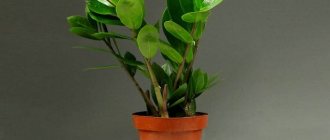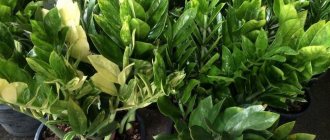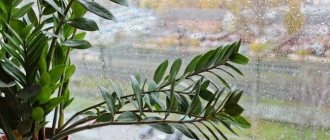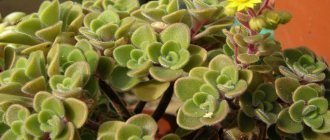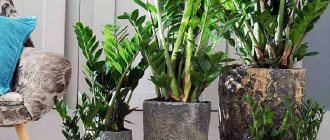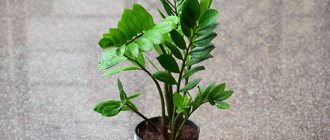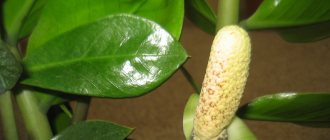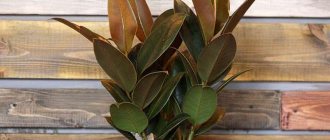This exotic handsome man won the love of Russian citizens in the late 90s. A beautiful evergreen plant appeared in Dutch nurseries. As a result, Zamioculcas settled in many apartments and offices. The flower has poisonous juice, but it does not emit any toxic fumes. Therefore, keeping it at home is completely safe.
Zamioculcas - belongs to the aroid family. This unpretentious evergreen plant in most of its characteristics is closest to succulents.
The flower has the following unique names:
- Dollar Tree;
- Currency tree;
- Money Tree;
- Eternal Tree;
- Zanzibar Pearl;
- Woman's happiness;
- Flower of celibacy.
His homeland is Africa. The plant received its unique name due to its similarity with zamia. Given its Latin roots, zamiya means loss or damage.
The flower is perfect for interior decoration because it has a pronounced external decorative effect. If good conditions are provided, the length of the plant can be up to 80 centimeters or more. Zamioculcas is a perennial, but does not live more than 10 years.
The closest “relatives” of the plant are Monstera and Dieffenbachia. Its distinctive feature is its straight-growing glossy leaves, attached to the stem by long cuttings.
Popular types
Zamioculcas appeared in flower shops 20 years ago. During this time, breeders have developed several different species, the most popular of which for home cultivation are:
Zamioculcas zamiifolia
Zamioculcas zamifolia / Flowering
This is the most typical representative of the plant . This is what refers to the “money tree”. A beautiful ornamental bush with bright fleshy leaves. The plant looks so perfect that it feels like it is artificial. An amazing plant that hides its trunk in the soil. For the first time weeks after growth, the flower does not form roots. Instead, there is a tuber that stores large reserves of water. The tuber is somewhat reminiscent of a dark marsh or brown potato. Has the shape of an ellipse.
Looking at the pot with the plant, it seems that bright green leaves are growing directly from the soil. The leaves are attached to the tuber using a long stalk, which unknowing gardeners mistake for the trunk. The length of the leaves reaches 60 centimeters . The leaves grow from a tuber and are divided into 8-12 individual leaflets. This is very rare for this species. The feather is dense, glossy and has a thick, juicy axis in which the flower stores moisture.
The plant grows in height very slowly. The cost of a shrub in a flower shop depends on its height; the longer, the more expensive.
Zamioculcas variegate
Zamioculcas variegated
Variegated or variegated Zamioculcas is very difficult to find in flower shops. His homeland is the island of Madagascar. At home it can reach a height of 1 to 1.5 meters. The leaves are arranged symmetrically in strict order. They have a bright green color, juicy flesh, and pointed ends. Flowers rarely appear on the plant, with very good care. The inflorescence is formed in the shape of a spadix.
Zamioculcas lanceolata
Zamioculcas lanceolate
Received this name because of the elongated leaves of the original lanceolate shape. The flower was first exhibited at flower auctions in Holland at the end of the 20th century. Its height reached 1.5 meters and above. In 2007, a miniature plant was bred, not exceeding 60 centimeters in height. Its leaves are an exact copy of its progenitor, only in a reduced size.
Black zamioculcas (Zamioculcas Blak)
Black Zamioculcas
The plant has leaves and cuttings of almost black color. Otherwise, it is completely similar to Zamioculcas zamifolia. The same fleshy leaves, pointed at the tips, attached symmetrically on both sides on a common stalk. The young bush has salad-colored leaves. As they mature, they begin to darken. At the same time, their color is not affected at all by the lighting in the room. No matter how the florist tries to lighten the leaves, he will not succeed. This “tree” looks very impressive. Therefore, it will perfectly decorate any room.
Looking at a flower from the side
The dollar tree is a neat bush with original leaves, which are covered with a thin layer of waxy coating and consist of 8 or 12 separately growing feathers. Each specimen has a fleshy structure in which moisture accumulates in case of dry periods. The tuberous rhizome also retains water in a similar way. It is often called a natural reservoir of moisture for a rainy day.
The dollar tree can grow up to a meter in height and decorate any home interior. Unlike the money tree (crassula), it periodically blooms with an unusual inflorescence. When you look at the flower from the side, it seems that a yellow or cream-colored corncob has appeared among the fleshy leaves. In fact, this standing bud consists of many miniature flowers that shine brightly in the afternoon sun. Usually the inflorescence is hidden under a light green blanket, so it is not immediately noticeable. The photo clearly shows the dollar tree during its flowering period.
Since the plant originated from the tropics, it is quite rare to see its buds in Europe. However, the flower is prized for its attractive foliage.
The plant was first described in 1828 by the famous collector of tropical flora K. Loddiges. He named it Caladium zamyefolia. 28 years later, Heinrich Schott, an Austrian biologist, included it in the list of tropical plants as Zamioculcas Loddiges. Only in 1908 did the director of the botanical garden in Berlin immortalize his modern name. Despite this, many indoor plant lovers know the flower under the name dollar tree.
Since the plant blooms very rarely, its leaves are considered its main advantage. It grows up to 100 cm and above, when suitable conditions are created. How to achieve this result when caring for a flower? It turns out it's not difficult. The main thing is to follow simple tips.
Since Zamioculcas is considered a poisonous plant, replanting or pruning is performed with gloves. Otherwise, getting the juice on exposed skin leads to unpleasant burns that take a long time to heal.
Care
The plant does not require careful constant attention. Growing a healthy dollar tree is not difficult. In its natural habitat, the flower is accustomed to difficult growing conditions. Therefore, it is not at all capricious in care, location and choice of soil.
Also read: Unpretentious decorative spurge - Synadenium
Watering
The health of the currency tree depends on proper watering. The plant is able to accumulate liquid, so it tolerates drought more easily than excess moisture. Excess moisture causes tubers to rot. Lack of moisture can be seen in the thinning of the leaves and their limp appearance. During prolonged drought, the flower may shed its leaves, especially during periods of intensive growth.
The following watering scheme should be followed:
- Spring and summer are the period of plant growth. Therefore, the flower needs extra moisture. Watering is carried out 3-4 times a month;
- Winter and autumn refer to the dormant period when the plant rests. It is necessary to reduce the frequency of watering to 1-2 times a month.
Settled water at room temperature is suitable for irrigation. Before moistening the soil, make sure the soil is completely dry. If excess water leaks into the pan, it must be drained immediately. When it stagnates, putrefactive processes begin.
Lighting
This is a light-loving plant. Although it brings great darkness. The best location is the window sill of a south window. You should not expose the flower to direct sunlight, as the leaves can get severely burned.
- It is worth hanging a small curtain on the window to create a slight oppression, especially in the summer season.
- Without good lighting, the leaves of the dollar tree become thinner. They become slightly sluggish, and the bush loses all its decorative charm.
- It is especially important to create bright lighting during the period of increased plant growth: spring and summer. In order for the growth to be uniform, you need to turn the flower towards the window with different sides, otherwise the symmetrical shape of the leaves will be absent.
The plant loves fresh air. Therefore, during the warm season it should be taken out into the garden or onto the balcony. It is first necessary to provide the eternal tree with slight shading and protection from precipitation.
Temperature
The plant comes from Africa, so it loves warmth very much. Intense heat exceeding thirty degrees will not cause any harm to the bush. Experts involved in breeding zamioculcas believe that the optimum temperature for normal growth and development of the plant is from 22 to 26 degrees .
A drop in temperature in winter to 16 degrees will not harm the bush at all. It should be noted that if the air temperature drops below 12 degrees, the plant may die. Sudden changes in temperature are also harmful to it.
The dollar tree does not like drafts.
Humidity
The flower tolerates dry air well. Spraying the plant with water is not an urgent need. It should be carried out when dust has accumulated on the leaves, which will be much more convenient to remove.
Only warm water is sprayed. Then the leaves are gently wiped with a damp soft cloth. Most often such “cleaning” should be carried out in the summer.
The soil
The soil for the plant should be loose and light, capable of allowing moisture and air to pass through well. Flower shops sell special formulations specifically for succulents.
You can prepare the soil yourself. You will need the following components:
- Turf land;
- Leaf soil;
- Peat;
- Sand.
All components are taken in equal proportions and mixed thoroughly. Flower growers advise adding a little sphagnum moss to this composition. The Zanzibar pearl does not like acidic soil, so the acidity of the soil should be neutral.
Before use, the soil must be disinfected. To do this, it is heated in a water bath for 10-15 minutes. You can also spill the soil with special chemical compounds or a weak solution of manganese. Some plant growers spill boiling water on the soil.
Transfer
Zamioculcas is a slow growing plant. Therefore, he will not need frequent transplants. A young flower is replanted once every two years. For a fully formed adult shrub, replanting once every five years is sufficient.
You need to be careful. The flower does not tolerate even minor damage to the tubers. In order not to injure the money tree, it is replanted while preserving the old soil. A complete replacement of the soil is possible only if the plant becomes ill or needs to be divided.
It is better to choose a stable clay pot for the flower. The transplant is carried out according to the following instructions:
- Using a flat, wide tool, you need to carefully remove the plant from the old pot along with the soil.
- Drainage is placed in the new container. There is no need to add coins to it. Such superstition can lead to oxidative processes that harm the plant tuber;
- The drainage is lightly filled with new soil;
- The plant is clearly located in the middle of the new pot and sprinkled with soil on all sides. The tuber should not be deeply buried; it should rise slightly above the surface.
- The plant is watered with a small amount of water.
Also read: Useful plant - Aloe vera: proper care and folk recipes
After transplantation, the currency tree does not require any special care. It is put back in its original place. The plant can only be replanted by dividing the tuber into two or more parts. This is a painful procedure. Therefore, if this method of propagating a flower is not planned, then it is better to transplant the tuber as a whole.
Fertilizer
It is best to purchase special fertilizer in the store. For indoor plants, it is diluted half and half with water. The flower especially needs fertilizer during the period of active growth and flowering, that is, from April to October.
During the dormant period, you should not fertilize the plant.
In addition to horse feeding, you can use foliar feeding. It is carried out in spring and summer no more than 1-2 times a month. To do this, the leaves of the plant are sprayed with a urea solution. The procedure is carried out between waterings.
Problems during cultivation
Even when growing an unpretentious dollar tree, problems can arise. Sometimes zamioculcas does not grow, sheds its leaves or loses its attractive appearance. As a rule, such manifestations indicate violations of agricultural technology. If the problem is identified in a timely manner, it can most often be eliminated without harm to the life of the plant.
External manifestationsCausesRemedies
| Zamioculcas leaves turn yellow | Most often this is a natural aging process. Zamioculcas can also respond to critical violations of agricultural practices by yellowing and dropping leaves. You should worry if the process also affects young leaves. | Follow agricultural techniques - do not overdo it with watering, but remember that in the summer it is advisable not to let the earthen ball dry out completely. Do not keep the plant in too cold rooms. |
| Spots on leaves | The cause of dark, wet spots is waterlogging, possibly combined with low temperatures or drafts. Yellow dry marks indicate exposure to direct sunlight or too dry air. | Follow agricultural practices, do not over-water the zamioculcas and protect it from excessively low temperatures. Do not place the pot on south-facing windows. Remember that in summer part of plant care should be spraying. In winter, keep it away from batteries. |
| The trunk turns black and the roots rot | This indicates overwatering. Dark but dry, "painted on" spots on the central veins of leaves may appear naturally during growth. | Remove the plant from the pot, cut off all damaged parts, treat healthy tissue with charcoal or Fundazol. Plant in a tighter container; Before new shoots appear, reduce watering until the earthen clod is completely dry. Do not forget that the dollar tree has an extremely negative attitude towards excess moisture. |
| Dollar Tree Doesn't Sprout New Shoots | Zamioculcas grows slowly, but if there are no new shoots from month to month, this indicates that the plant does not have enough light or nutrients. | Move the zamioculcas to a more illuminated place and feed it regularly. |
| Zamioculcas is crying | Sometimes droplets of moisture appear on the leaf plates, looking like tears. This is an alarm signal indicating mechanical damage or improper care. | Follow agricultural practices. |
Zamioculcas can be affected by spider mites. The appearance of the pest can be determined by a thin web and deformed upper leaves that are lagging behind in development. To combat it, acaricides are used, such as Neoron, Fitoverm, Aktofit. Treat the plant at least twice, with a weekly interval. Without the second processing there is no point in doing the first; the same goes for frequency.
Occasionally, a scale insect may settle on a dollar tree. Adults are easy to spot - they are waxy brown or brownish tubercles on the leaves and trunk. They are removed with cotton swabs dipped in a weak solution of alcohol. Of course, such a procedure will not help get rid of pests - the scale insect has a complex phenology, in many phases it is indistinguishable to the naked eye - but it will reduce their number. To completely get rid of them, use any systemic insecticides, for example, Fufanon, Aktaru. Tanrek shows good results in the fight against coccids.
Reproduction
The plant is expensive in flower shops. It will not be difficult to dilute it at home. There are three known methods of breeding Zamioculcas:
- Tuber division.
- Cuttings.
- Leaf propagation.
Each method has its own characteristic features:
Tuber separation
This method of flower propagation is possible if there is a large mother tuber. It is necessary to remove the tuber from the pot and remove all the soil. There are buds on the rhizome, from which lateral shoots can later form.
A tuber with only one bud cannot be divided. Separation is carried out with a sharply sharpened, disinfected knife. The tuber should be cut lengthwise so that there are several buds on each side. The cut is sprinkled with crushed sand of black activated carbon.
After 2-3 hours, the plant can be planted in the prepared pot. If there is no lateral shoot growth point on part of the rhizome, the plant will die.
Cuttings
This is the most acceptable method for propagating Zamioculcas. Cuttings are suitable for mature plants with several side shoots.
The larger the cutting, the greater the likelihood of growing a full-fledged flower from it. The cutting retains many nutrients, which promote faster rooting than when propagated by leaves.
A cutting is a shoot of Zamioculcas that has at least one bud.
Cuttings go through the following stages:
- We choose the most suitable part of the plant for this;
- We cut it off with a scalpel or a sharpened knife. The instrument must be sterile;
- Pour warm water into a container with a small amount of activated charcoal or charcoal;
- Place the shoot cut side down in the container;
- We are waiting for the roots to form;
- Plant it in a pot.
For germination, it is necessary to maintain a temperature of at least 20-22 degrees and keep the shoot in good light. The water is constantly refreshed, otherwise the cutting may rot.
You can carry out cuttings in another way. To do this, a cut of the rhinestone shoot is treated with charcoal. After a few hours, a special plug will form at the cut site, which will prevent the plant from rotting. Now it can be placed in the moist soil of the pot, so that the lower part of the bud is covered with soil, and the upper part remains on the surface.
You can make a small greenhouse for the transplanted plant, then rooting will go faster. When watering, the main thing is not to get on the bud, otherwise the plant may die.
In order to see the formation of roots, it is better to plant in a transparent container - a plastic bottle or glass. Drainage holes should be made in them using a sharp tool. After the roots have formed, the plant must be transplanted to a permanent location.
Leaf propagation
The plant can be propagated by a whole leaf or leaf blades. The process of obtaining a tuber from a leaf can take up to six months. It all depends on the planting material. The more leaves you can take, the faster the tuber will form.
If a whole leaf is used for propagation, its lower parts should be removed. It is placed in warm water in a well-lit, warm place. The water is changed every other day. When the first roots appear, the leaf can be immediately planted in a prepared container.
It should be noted that if exposed to direct sunlight or stagnant water, the leaf will die.
Landing rules
It is necessary to plant in early spring before the vegetative buds begin to bloom. To plant adult, large specimens, use a floor-mounted ceramic or plastic pot slightly larger in size than the tuber.
Zamioculcas flower photo flower
It is important that there are holes at the bottom to drain excess moisture. The pot should be tall and not too wide.
First, fill in a couple of handfuls of expanded clay or pebbles, then add fertile soil up to half the volume. Lower the tuber, fill all the voids to the top, crush it around the stem, and moisten it with warm water. After planting, the branches should be tied so that the plant is stable.
Many gardeners place the pot in a flower pot or other decorative container, which gives it a special decorative and original appearance.
Trimming
Pruning is not a prerequisite for proper plant care. It is carried out only to give it a certain shape or rejuvenation. You can trim any part of the plant: tuber, leaves, cuttings. The main thing is that the pruning tool is very sharp and sterile. A scalpel, garden pruning shears, and a sharp knife will do.
Also read: Haworthia - popular species and care at home
The cut area must be sprinkled with crushed activated carbon. This will quickly stop the leakage and block access to the “wound” for pathogenic microorganisms. Often pruning is used to treat the currency tree.
Diseases and pests
The flower is very resistant to various diseases. Therefore, it practically does not get sick and is not affected by pests.
Incorrect care can lead to a painful state. The most common reason is over-watering. The root system of Zamioculcas begins to rot. In this situation, the flower requires urgent transplantation. It is necessary to inspect the rhizome and remove all putrefactive damage.
If a currency tree's leaves turn yellow, this does not indicate disease. This is how the normal growth process occurs. Old leaves die and turn yellow, replaced by new green leaves. Yellowed leaves are removed only after complete wilting with a sharp tool.
Reanimation of Zamioculcas
If the indoor zamioculcas has turned very yellow, or even its entire above-ground part has disappeared, then there is no need to rush to throw away the ornamental plant. It is enough to carefully remove it from the soil of the flower pot and carefully inspect the entire root system. Maintaining elasticity and the absence of signs of severe rotting of the root system make it possible to preserve the indoor plant.
The underground tuber of the ornamental crop must be washed very thoroughly, but carefully, in a warm and weak solution of potassium permanganate, then dried a little at room temperature, and then planted in a new nutrient soil mixture. The flower pot must be provided with a high-quality drainage layer. In this case, competent and high-quality further care, as well as providing the most comfortable conditions, allow the ornamental plant to quickly form new young shoots.
Why isn't it growing?
Sometimes it seems to the owner that the plant is practically not growing, and at the same time there are yellowed leaves. In this situation, you need to check the temperature, the presence of drafts and pests. It is possible that the breeder forgot to water the plant at the time.
Slow growth is a distinctive feature of this plant. Don't try to add more fertilizer or increase watering. If new shoots do not appear for a long time, it is worth reconsidering the location of the money tree and paying attention to the water with which the plant is watered. It should be clean and warm.
Botanical description
Zamioculcas (lat. Zamioculcas) lives in the tropical zones of Africa, belongs to the Araceae family and has 1-4 species (depending on the source). The name comes from the similarity of the leaves of Zamioculcas with the leaves of Zamia, which grows on the American continent. Zamioculcas is a low-growing herbaceous plant. The rhizome is a tuber, the roots are fleshy and thick. Rachis is thick and juicy - it is necessary for the plant to store water. The feathers are dense and leathery to the touch. The leaf can grow up to 1 m in length. During prolonged drought, Zamioculcas sheds leaves from the upper part of the leaf, which allows the plant to reduce moisture evaporation, and the petiole at the bottom is designed to conserve water for the plant. Moisture is also stored in the underground tuber. If Zamioculcas grows well, it can bloom indoors. A thick and short peduncle grows from the base of the leaves, on which a light cream spadix, the inflorescence, rests.
Bloom
It is rare that a gardener manages to see the flowers of this ornamental plant. But this does not mean poor flower care, since the appearance of flowers in Zamioculcas, even in its homeland, is a rare occurrence.
The inflorescences have an unusual spadix appearance, in which the male and female flowers are located on opposite sides and are separated by a row of sterile flowers. Inflorescences appear in the lower part of the plant, at a distance of 20 centimeters from the ground. This arrangement does not allow self-pollination. Pollination is carried out by small insects and the wind.
In place of faded flowers, small berries filled with seeds appear. It is impossible to get a ripe fruit at home. Experienced plant growers claim that the period of appearance of the first flowers largely depends on the location of the plant. So, if you place it on a “northern” windowsill, flowers will appear towards the end of the dollar tree’s life. Choosing a “southern” window promotes earlier flowering.
Rituals to attract wealth
But in order for the money to arrive especially quickly, you need to perform a couple of simple rituals with the plant. For example, take a dollar bill with a denomination of 1 dollar and fold it so that it forms a triangle in which the pyramid is clearly visible. This figurine will need to be hung on a zamioculcas branch, and then it will lure money into the house. The main thing is to make sure that the bill does not fall out of its place.
Also, according to signs, you need to water the plant with “money water” from time to time. To make it, you need to take a bottle of water and drop a few coins at the bottom, the denomination of which is absolutely unimportant. This water should sit for a couple of days, and then you can pour it over the zamioculcas. And this needs to be done every few days until the water runs out. That's when the money will start coming.
A new coronavirus mutation has been discovered in France: it can “cheat” the test
Anaerobic exercises, isometrics: deciphering common fitness terms
Sheep on the highway and other photographs for an international photo competition
Signs and superstitions associated with the plant
Now it is difficult to find the origins of the plant’s popular name. Why did it come to be called the “currency tree” and every banking institution must have it in the reception area.
A huge number of superstitions and signs are associated with this shrub, especially regarding female happiness. For example, one of its popular names, “flower of celibacy,” indicates that a young girl who has similar decor in her home will never receive a marriage proposal.
But there are some deviations in this myth. If a girl bought a flower herself, then she will not see female happiness, but if it was given to her, good luck in amorous affairs is guaranteed. In this case, the flowering of the plant is considered especially lucky. This indicates that the wedding is very close.
- It is important to give a shrub on a special day, such as New Year, Christmas or a birthday. It is believed that it will bring great luck and rapid career growth, which will lead to increased material wealth.
- The presence of a flower in the house is associated with increased health and well-being . But for this, the plant must be loved, since it senses the energy emitted by its owners. For a good attitude, the plant emits positive radiation.
- The donated shrub should be immediately transplanted into another pot . This will ensure an influx of money. In this case, it is necessary to bury coins in the ground. This will help the bush “tune in” to the radiation of monetary energy.
- Any growth of the plant, the formation of cobs is regarded as an indication of imminent financial well-being . In this case, the receipt of funds must be in dollars.
Buck (currency, euro) tree in the interior
- According to the teachings of Feng Shui, it is best to place a pot with a Eurotree in the southeastern part of an office space or room in an apartment, so it can effectively attract financial flows into the house.
- Zamioculcas looks best on a table or stand near the window.
- You can also place the pot in the back of the room, where there is diffuse lighting for at least 6 hours a day.
You will find even more useful tips on where to place the flower, as well as photos of Zamioculcas in the interior of the apartment on this page.

